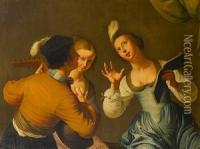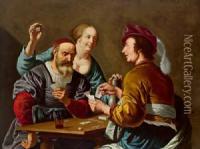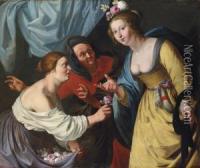Albert Jansz. Van Der Schoor Paintings
Albert Jansz. Van Der Schoor was a Dutch Golden Age artist, born in 1610 in the Netherlands. Though not as widely recognized as some of his contemporaries like Rembrandt or Vermeer, Van Der Schoor was part of the vibrant artistic scene of the 17th century in Holland. He primarily worked as a still life painter, a genre that was becoming increasingly popular during this period among wealthy Dutch patrons who sought to decorate their homes with depictions of luxurious and exotic items.
Van Der Schoor's works often featured arrangements of books, scientific instruments, musical instruments, and other symbols of the intellectual pursuits and wealth of the Dutch middle and upper classes. His style was characterized by a meticulous attention to detail and a keen ability to render different textures and surfaces, from the softness of feathers to the translucency of glass. This skill suggests that he had a deep understanding of the properties of light and shadow, something that was a hallmark of Dutch painting at the time.
While Van Der Schoor's name might not appear in the annals of art history with as much frequency as some of his peers, his contributions to the still life genre are noteworthy. The Dutch Golden Age was a period of great wealth and cultural achievement for the Netherlands, and still life painting reflected the era's fascination with commerce, science, and the accumulation of knowledge. Van Der Schoor's paintings would have been a testament to these values.
There is limited biographical information available about Van Der Schoor's life outside of his work. It is known that he lived and worked in the Netherlands throughout his career, and he likely trained with a local master, as was customary for artists of the time. His works would have been commissioned by the affluent members of Dutch society, and his paintings would have been a reflection of their tastes and interests.
Albert Jansz. Van Der Schoor died in 1683. His works remain as a testament to the skill and craftsmanship of Dutch Golden Age painters, and they continue to be studied by art historians and appreciated by art lovers for their beauty and historical value. While he may not have the same level of fame as some of his contemporaries, his contributions to the art world during one of its most flourishing periods are undeniably significant.


